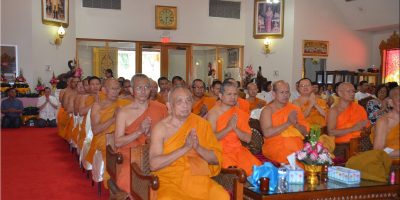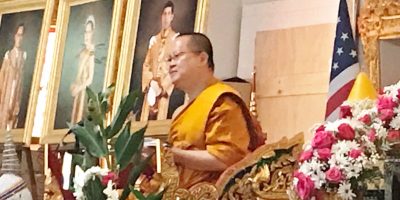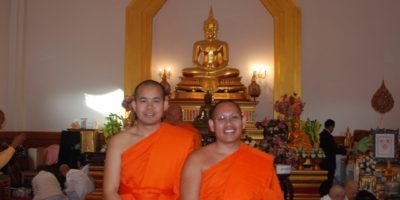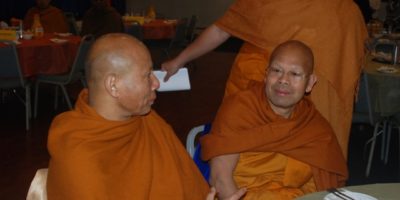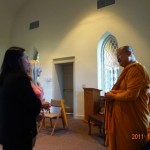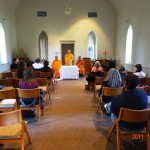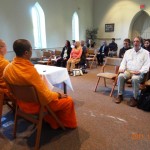September 15, 2011
Venerable Thanad Inthisan, Ph.D.
Secretary General, The Council of Thai Bhikkhus in the U.S.A.
13440 Layhill Rd, Silver Spring, MD 20906
Dear Venerable Dr. Inthisan:
The purpose of this letter is to formally invite you and your team, to be the Guest Speakers at the Pennsylvania State University – Mont Alto, on October 17, 2011 on the topic “Women in Buddhism,” as well as conducting a special workshop on “Relaxation and Stress Reduction Through Breathing Exercise.”
The lecture and workshop will open to all students, faculty, and staff. The tentative schedule will be:-
1: Special Workshop: Relaxation and Stress Reduction Through Breathing Exercise [2.00 PM -3.00 PM].
2. Special Lecture: Women in Buddhism [3.30PM-5.30PM]
We would be pleased and honored if you would consent to be our speaker at the PSU Mont Alto. Our students will benefit tremendously from your expertise in Buddhism.
I will contact you shortly to follow up on this. Please also advise us on preparation for the Special Workshop on Relaxation, i.e., room set up, and participants’ preparation.
Thank you for your willingness to share your expertise in this subject with us.
Yours sincerely,
Stephanie Unger, Ph.D., RN., CNE.
The Pennsylvania State University
One Campus Drive, Mont Alto, PA 17237
Phone: 717-749-6212 Fax: 717-749-6039
E-mail: ssp13@psu.edu http:// http://www.ma.psu.edu/
An Introduction to the Workshop “Stress reduction & Relaxation”
Today I would like to introduce a meditation technique for reducing stress and enhancing relaxation. The term “meditation” is used in Buddhism for “mind training” rather than the Western sense of “reflection.” It does not require developing an extremely deep stillness, just relaxation and peace. It does, however, involve studying everything that occurs internally during the meditation practice. Together, the book and the audiocassette explain the technique and provide the tools for putting it into practice.
Modern life is filled with stress. More and more individuals, suffering under social pressures, are turning to meditation as an effective remedy with the ability to relieve stress while also elevating both external functioning and internal peace.
This technique does not require any special religious beliefs or practices. It is founded on scientific principle that works for all, and has been successful tested by a cross-section of international meditators from various cultural and religious backgrounds. It can work for you.
The six steps for stress reduction and relaxation
1. The Sitting Position
Some people prefer to sit on a hard, straight chair, but most sit on cushions on the floor. You can stack up two or three cushions, if that is more comfortable. Sit on the front one-third of the top cushion, so that it helps to keep you from falling backwards.
Make yourself comfortable in any position you like. Usually we use the Lotus Position. Cross your legs – your right leg over the left. Sit upright. That is more important than anything else. Keep your spine straight and vertical. Relax. You may cross your hands and place them in your lap, or hold your knees – whichever is more comfortable. Relax your entire body, just keeping the spine straight. Check your sitting position to make it most comfortable. Lean sideways – to the right and left, then front and back. Finally, return to the center, perfectly upright and balanced.
All of this should be relaxed. Don’t be stiff. Relax, but sit upright. Keep your back straight. Hold your head up, with your chin so that your eyesight is parallel with the floor. Relax. Then, close your eyes and your mouth softly. Check again that you are comfortable and can sit in this position for a long time. This is the sitting position.
2. Relaxing
Visualize that you are the boss. The mind is the maker – the mind is the doer. Set your mind to checking your muscles from your feet up to your head – up and down, back and forth. Makes sure that all of your muscles are relaxed.
Start from your feet, then to your ankles, your legs, your knees, and your things. Then, check from the navel down – this is the lower part of the body. Every muscle should be relaxed.
Now, check from the navel up to the shoulders – this is the central part of the body. Check that the abdomen, chest and shoulders are relaxed. Check the shoulders again – relax further. Check your arms and your hands. Relax all your arm muscles. Relax your hands and your fingers.
Now check your neck and your head – this is the upper part of the body. Lower, raise, and twist your head to stretch the neck. Then, relax the neck muscles. Next, visualize starting from your scalp, your forehead, your eyebrows, your eyelids, your cheeks, your ears, your upper lip, lower lip, and, finally, your chin. Make all of this relaxed.
Check up and down, back and forth from foot to head a couple of times. Visualize checking the relaxation of your muscles. Let your mind work for you. You are what you think you are. Think big – think relaxing.
3. Mental Detoxification
Next, we come to mental detoxification – cleansing the mind and body. You shower to clean your body on the outside. Mental detoxification is the technique for internal cleansing. When your sensory organs come into contact with external stimuli, you use some of the energy coming in, but the left over forces turn into toxins. Toxins enter the body through all six of the sensory organs – the eyes, the ears, the nose, the tongue, the skin, and the mind. You must get rid of these toxins everyday to purify your mental and physical facilities and keep them functioning well.
Toxins are the cause of stress – the cause of sickness – the cause of laziness. When you eliminate all of the toxins, you will feel fresh and enthusiastic – ready for action. You will be alert in mind and body.
We get rid of toxins through mental detoxification. As you take a deep breath, visualize that good, clean oxygen comes inside. This is the chemical for cleansing your mind and body. Inhale and hold your breath briefly, to let the oxygen spread throughout every cell in all parts of your body. Then, exhale, while silently reciting to yourself “release.” Visualize that the oxygen cleans up all of the toxins that contaminate your body.
Inhale good oxygen. Hold your breath a little bit, and exhale, with a sense of release. This is the technique for mental detoxification. Relax. Recite for yourself “release” every time you exhale. Sense that you are releasing the toxins. Be your own boss. Use your mind to clean up the body. Also, cleanse any toxins that are clouding your mind. Every time you exhale, recite silently “release,” and feel your mind working for you to clean up your whole system.
When your mind becomes blurred, it is because of unwholesome thoughts – thoughts concerned with desire/greed, or anger/hatred, or confusion/delusion. While you are engaged in detoxification, try to eliminate greed, hatred, and delusion, as much as possible.
Visualization is what makes mental detoxification effective. Your mind must be very strong. Be mindful and use your mind power to clean inside your body and mind. You are what you think you are. Think big. Think success. Think accomplishment. Then, your mind will work for you. Relax. Clean up both your mind and your body. A sound mind and sound body must work together for good, coordinated, functioning.
When you are finished with mental detoxification, go back to checking again. Feel the relaxation of the muscles from your feet up to your head one more time. Repeat checking up and down. Now, you may adjust your sitting position – not too tight, not bending forward or backwards. Arrange yourself into a good, comfortable position in which you can remain for a long time. Now, get back to knowing you body. Visualize that your feet are relaxing – then, your ankles, your knees, your legs, your thighs, the lower part of the body, the central part of the body, and the upper part. All of these muscles are relaxing. Repeat your checking up and down.
The mind is the master – the mind is the doer = you are what you think you are. The mind can work for you. Be mindful, following and knowing the actions of the mind.
4. Knowing Your Breathing
Next, learn to know your breathing system. First, know it while breathing is normal – inhale and exhale normally, knowing your breathing. Next, dramatize it in order to see your breathing clearly. Take a deep breath and hold it a little bit – follow the breath from your nose all the down to your abdomen. Then, exhale. Now, take a medium breath – just from the nose down to the chest. Then, exhale. Finally, take just a short breath. Force the breath quickly in and out just at the nose. Thus, we have learned to know three rhythms of breathing – deep, medium and shallow.
Breathing can also be coarse and rough, like snoring, or very fine and smooth. Try experimenting. Take deep, medium and short breaths. Then, make your breathing rough and coarse, or very fine and smooth.
Emotions are attached to breathing. When you are in a bad mood or get heated up and almost lose your temper, you take very short, rough breaths. When you take short breaths, you get less oxygen and feel tired. This heats up your temper. That kind of breathing makes you very emotional.
Knowing your breathing is useful for controlling your emotions. Work with breathing rhythms. They become the tools for controlling your emotions. You may have heard one person telling another “calm down, calm down – take a deep breath.” This is, in fact, the technique. To calm down, take deep breaths that are very fine. You will soon get back to normal. The more you keep cool and calm, the more peace and happiness you will attain. When you become hot-tempered and blow your top, you create more stress and feel even worse.
This completes the major components of knowing – knowing your sitting position, knowing your body and relaxing your muscles, mental detoxification, and knowing your breathing rhythms. We shall now discuss two related topics emphasized in Eastern philosophies – knowing the great elements and knowing impermanence.


